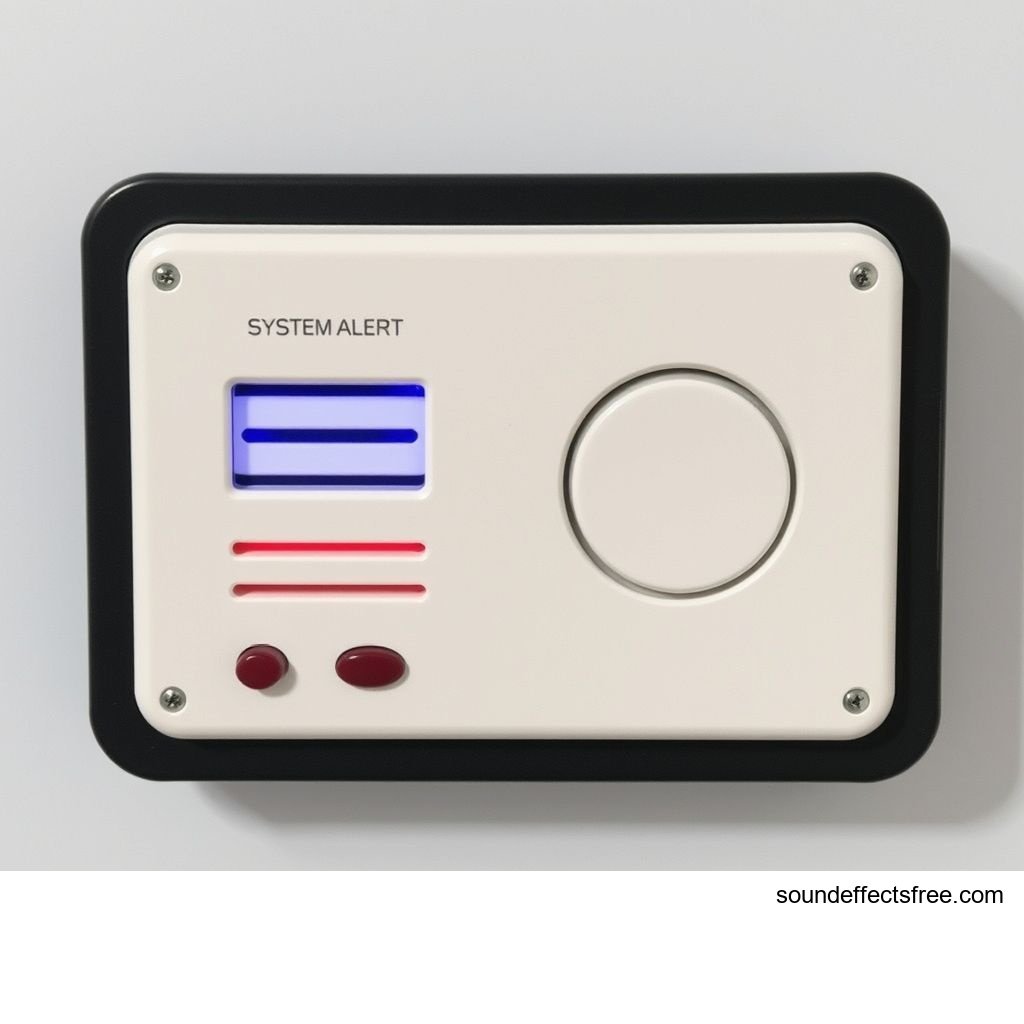Subtle Negative Alert: Enhancing UI Feedback
A subtle negative alert plays a crucial role in modern user interfaces. It provides immediate auditory feedback. This sound confirms when an action fails. It signals a negative outcome without being overly disruptive. Effective UI/UX design often relies on these small, informative audio cues. They guide users smoothly through digital experiences. A well-designed negative alert can prevent frustration. It improves overall usability, making interactions more intuitive.
Applications in Media
Subtle negative alerts are vital across many media types. They are used in video games, mobile applications, and even enterprise software. These audio effects signal a problem. They do so without a harsh, jarring sound. In gaming, a subtle negative sound might indicate a failed action. For apps, it could confirm an invalid input. This type of audio feedback ensures clear communication. It helps users understand why something did not work as expected. The goal is always a smooth user experience.
Industry-Specific Uses
Many industries rely on specific uses of the subtle negative alert.
Gaming: In games, a subtle negative alert warns players of low health. It indicates a failed attack. Or it marks an incorrect puzzle solution. This immediate sound sample helps players adjust strategies quickly. It provides vital feedback without pulling players out of the immersion. The negative outcome is conveyed instantly.
Mobile Apps: Mobile applications use these alerts for various errors. Think of an invalid password entry. Or a failed payment transaction. A distinct audio effect signals the error. This helps users correct mistakes efficiently. The subtle negative alert confirms the system recognized an error.
Enterprise Software: Complex software benefits greatly from clear negative feedback. Data entry errors, permission denied messages, or failed save attempts all need this cue. A soft, clear audio effect prevents confusion. It helps users understand an issue quickly. This makes workflow smoother.
Automotive UI: Modern car dashboards feature complex UIs. Subtle negative alerts can signal open doors or low fuel. They provide critical warnings. These audio cues are designed to be informative yet non-alarming. They ensure driver focus remains on the road.
Creative Techniques
Designers use various creative techniques for subtle negative alerts. They might combine different sound elements. The aim is to create a distinct, yet non-intrusive sound. A designer might use a short, sharp click layered with a gentle, dissonant tone. This creates a unique negative signature. Varying the pitch slightly can also make a repeated negative feel less monotonous. The art lies in conveying the message effectively. It must not annoy the user.
Technical Analysis
Understanding the technical aspects helps in creating effective subtle negative alerts. These sounds are not just random noises. They are carefully designed audio effects. Their technical properties define their impact. A sound's waveform and frequency profile contribute to its perceived "negative" quality.
Waveform Characteristics
A subtle negative alert often has specific waveform characteristics. It typically features a very short duration. This means a quick attack and rapid decay. There is usually little to no sustain. This quick burst of sound is key. It delivers information instantly. The waveform might also show slight irregularities. These small deviations contribute to a dissonant or unsettled feel. They signal that something is amiss. This makes the sound feel distinctly negative.
Frequency Profile
The frequency profile of a negative alert is crucial. These sounds often contain higher frequencies. This makes them sharp and attention-grabbing. They might also feature dissonant intervals or clusters of frequencies. These are sounds that clash slightly. This clash creates a sense of unease. It signals a problem. Unlike pleasant, harmonically rich sounds, a negative alert avoids smooth overtones. It uses frequencies that inherently communicate a negative state.
Production Tips
Creating effective subtle negative alerts requires specific production techniques. Attention to detail is key. The right tools and methods ensure the sound is impactful. Yet, it must remain subtle.
Recording & Editing
High-quality recordings are fundamental. Foley techniques can create organic negative sounds. Think of soft clicks, small taps, or gentle scrapes. These sounds feel natural. Digital synthesis is also powerful for precise, clean alerts. Synthesizers can generate unique dissonant tones. During editing, apply subtle pitch shifts. These can introduce a desired negative quality. Gentle detuning makes a sound feel slightly off. Careful use of short reverbs can add a sense of space. This gives the negative feedback context.
Software Tools
Digital Audio Workstations (DAWs) like Ableton, Logic Pro, or Pro Tools are essential. They provide the environment for creating these audio effects. Software synthesizers like Serum or Massive are excellent for crafting unique, dissonant tones. Various effect plugins are also vital. Equalizers (EQ) shape the sound's frequency balance. Reverb adds depth. Chorus and flanger plugins can introduce subtle movement. These tools help refine the negative sound. They ensure it fits the UI context perfectly.
Creative Implementation
Beyond technical production, creative implementation ensures the negative alert integrates seamlessly. It should enhance the user experience. It must not detract from it. Think about how the sound interacts with other elements.
Layering Methods
Layering different sound elements enhances a subtle negative alert. Start with a foundational tone. Then add a short, impactful transient. This could be a tiny click or pop. Layering a subtle, filtered noise on top can add texture. This provides a rich, complex sound. Each layer contributes to the overall negative message. The result is a nuanced, informative audio effect.
Spatial Effects
Using spatial effects makes the negative alert more intuitive. Stereo imaging can make the sound appear to originate from a specific UI element. This guides the user's attention. Subtle panning can provide directional cues. Short delays create a slight echo. This gives the negative sound a sense of space. It immerses the user further. This thoughtful use of space enhances the overall impact of the negative feedback.
Sound Pack Integration
Integrating a subtle negative alert within a sound pack offers many benefits. It ensures consistency across an entire auditory design. A cohesive sound library enhances user perception.
Using with Other Sounds
This subtle negative alert needs to blend seamlessly with other sounds. It should not clash with background music. Or with other UI sounds. Consider pairing it with a [UI Confirm Tap](/ui-confirm-tap) sound. This creates a clear auditory language for success and failure. The negative alert should complement positive feedback. This ensures a consistent user experience. For related sounds, explore [Related negative sounds](/?category=ui-sound-effects).
Complete Collection
For comprehensive audio solutions, explore full sound packs. These collections offer a range of cohesive sounds. They provide everything needed for a complete UI audio experience. A full sound pack includes various alerts, confirmations, and background elements. These packs are designed to work together. This ensures a polished and professional audio design.
Get the full sound pack for comprehensive audio solutions.
FAQ Section
Q1: What is a subtle negative alert? A subtle negative alert is a brief audio cue. It signals a failed action or an error in a user interface. It provides feedback without being overly harsh. This type of audio effect guides the user subtly.
Q2: Why is audio feedback important for errors? Audio feedback is vital for errors because it provides immediate, non-visual confirmation. It alerts the user to an issue quickly. This helps prevent frustration. It improves the efficiency of user interaction with the UI.
Q3: How do you make a sound dissonant? To make a sound dissonant, use notes or frequencies that clash slightly when played together. Avoid traditional harmonious intervals. Introducing slight detuning or layering clashing tones creates a dissonant sound sample. This delivers a clear negative message.
Q4: Can a subtle negative alert be too subtle? Yes, a subtle negative alert can be too subtle if users consistently miss it. The sound must be noticeable enough to convey the negative message. Yet it must not be intrusive. Testing with users helps find the right balance for your UI.
Q5: Where can I find quality negative alert sounds?
Quality negative alert sound effects (sfx) can be found on professional sound libraries. Websites like [Pro Sound Effects](https://www.prosoundeffects.com/) offer extensive collections. Look for sound packs specifically designed for UI/UX.





